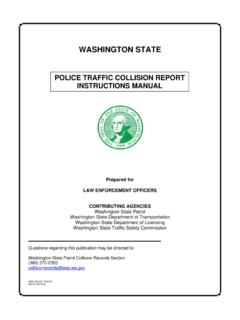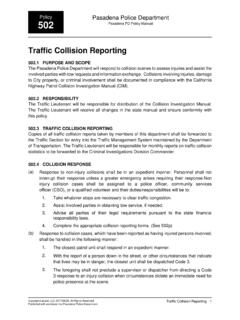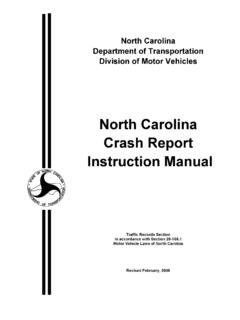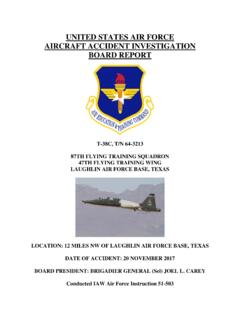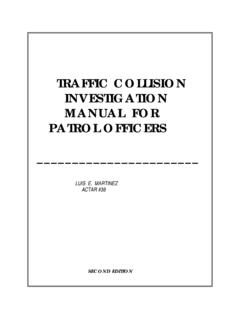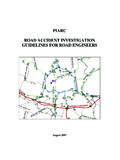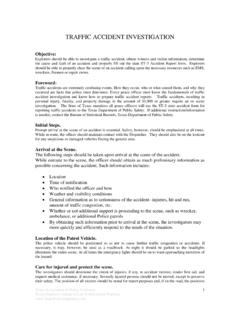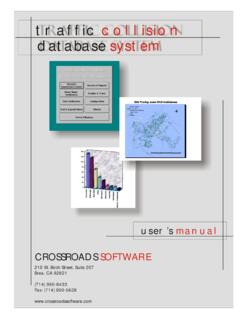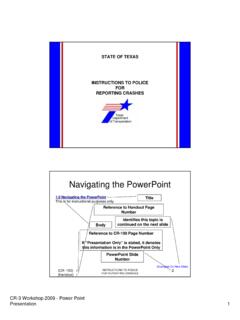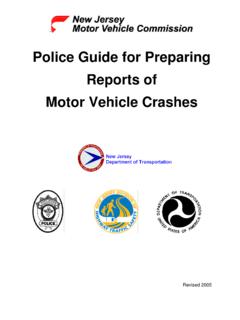Transcription of DRIVER DISTRACTIONS AND INATTENTION DATA …
1 DRIVER DISTRACTIONS AND INATTENTIONDATA SUMMARYASSEMBLY BILL 770 CHAPTER 710 Report to the Governor and LegislatureNovember 2002 Commissioner Dwight O. HelmickDepartment of California Highway Patrol D. O. Helmick, Commissioner J. A. Farrow, Deputy Commissioner M. J. Padilla, Assistant Commissioner, Field G. M. Augusta, Assistant Commissioner, Staff REPORT TO THE GOVERNOR AND LEGISLATURE2001/2002 Prepared by: Commissioner D. O. Helmick(916) 657-7152 November 2002 TABLE OF CONTENTSI ntroduction .. 1 data Collection 2 Overview of the Statewide Integrated traffic Records System (SWITRS) .. 2 data Collection - INATTENTION / DRIVER distraction .. 3 data Collection for AB 770 .. 5 data Analysis ..7 Findings .. 7 Existing 12 Effects of Cellular Telephone Use on DRIVER Behavior ..12An investigation of the Safety Implications of Wireless Communications in Vehicles.
2 12 The Effect of Cellular Phone Use on Driving Performance ..14 Influence of Mobile Phone Use While 15 Visual distraction While 16 High-tech Ford Test Generates data on Motorist 17 Conclusion .. 18 Recommendations .. 19 AnnexesAAssembly Bill No. 770, Chapter 710 BCHP 555, Page 2 ( traffic collision Coding)C CHP Comm-Net ( Collection of data for INATTENTION , Page 2, CHP 555, Other Associated Factors )D CHP Information Bulletin for Allied Agencies (IB #122) - Collection of data for INATTENTION , Page 2, CHP 555, Other Associated Factors E CHP Management Memorandum (MM #01-09) Collection of data forCellular Telephone Usage, CHP 555, traffic collision ReportF CHP Information Bulletin for Allied Agencies (IB #123) - Collection of data for Cellular Telephone Usage, CHP 555, traffic collision ReportGTraffic collision investigation manual , HPM , Revision #1 HInattention / Cell Phone Usage data (January 1, 2001 - June 30, 2002)
3 IINTRODUCTIONThe proliferation of mobile communication devices, particularly the cellular telephone,has enabled us to communicate at any time and anywhere, even while driving. Althoughthey may be a great convenience, a person s ability to drive safely while operating thesedevices may prove to be compromised by their use. Consequently, guidelines on theuse of mobile communication devices may be required, since all people, in general,have limitations in perception and information processing, particularly in a multi-taskenvironment such as operating a motor , a number of cities and states have either banned, restricted, or areconsidering legislation or ordinances governing the use of cellular telephones whiledriving. Most have been in response to concerns from the public who perceive cellular telephone use by drivers as a significant distraction . In 2000, the city of Berkeleycontacted the California Highway Patrol (CHP) requesting statistics relating to trafficcollisions involving cellular telephone use.
4 This inquiry was in response to local requests to consider an ordinance prohibiting their use while driving. At that time,information specific to cellular telephone use and traffic collisions was not being October 10, 2001, Governor Gray Davis signedAB 770 (Chapter 710, Nakano), which becameeffective January 1, 2002. This added Section tothe California Vehicle Code. Section reads: (a) Any traffic collision report prepared by a memberof the Department of theCalifornia Highway Patrol or any other peace officer shall include information as to whether a cellular telephone or other DRIVER distraction or INATTENTION is a known or suspected associated factor to the cause of a traffic collision . (b) Information described in subdivision (a) shall be collected and transmitted tothe department on or before July 1, 2002. (c) The department shall compile the information from its own members and thatsupplied by other peace officers.
5 (d) The department shall study the compiled data and make recommendationsconcerning the issue of DRIVER DISTRACTIONS and INATTENTION as they relate to associatedfactors to the cause of traffic collisions. The department shall developrecommendations for legislative or regulatory action to address these issues, and, as part of the study, the department shall review and analyze a sample of existing studiesrelating to the issue of DRIVER DISTRACTIONS and INATTENTION factors to the cause of trafficcollisions.(e) As used in this section, DRIVER DISTRACTIONS and INATTENTION include, but arenot limited to, the use of cellular telephones, electronic devices, radios, smoking, eating,children, animals, personal hygiene, reading, or other similar (f) The department shall submit a report regarding the study described in thissection to the Governor and Legislature, including findings and recommendations, on or before December 31, 2002.
6 (g) This section shall remain in effect only until January 1, 2003, and as of thatdate is repealed, unless a later enacted statue, that is enacted before January 1, 2003, deletes or extends that date. (Refer to Annex A.) data COLLECTION METHODOLOGYThe requirement for a Statewide traffic Records System was established by theNational Highway Safety Act of 1966. The development of California s StatewideIntegrated traffic Records System (SWITRS) was spearheaded by the CaliforniaHighway Patrol with the support and active participation of several other organizationsincluding: The League of California Cities The County Supervisors Association of California The California Peace Officers Association The California Office of traffic Safety The California Department of Transportation The California Department of Motor Vehicles OVERVIEW OF THE STATEWIDE INTEGRATED traffic RECORDS SYSTEMM otor vehicle traffic collisions are reported on the CHP 555, traffic collision Report, or an acceptable modification (Refer to Annex B).
7 The format was designed from input by various SWITRS users. The collision investigation manual (CIM) provides instruction for completing the traffic collision report forms. Approximately 400 city police departments and sheriff s offices and 101 CHP Areas investigate and report these collisions. Each day the CHP s Information Management Division, Support Services Section, receives approximately 3,000 collision reports from these agencies for processing. All reports are checked for completeness and coded for several data elements. State highway related collision reports receive additional coding to identify engineering details and needs. The following agencies and jurisdictions receive SWITRS data : The California Department of Transportation (Caltrans) receives collision data for state highway related collisions for their traffic Accident Surveillance and Analysis System (TASAS).
8 The system is used to identify collision prone locations. Such information is used to propose improvements and to justify priorities for expending traffic safety funds. State highways within cities and counties may benefit by receiving such improvements as signals at the base of freeway ramps or at intersections of state highways and local streets or roads. 2 The California Office of traffic Safety(OTS) is charged with reducing fatalities,injuries, and economic losses resultingfrom motor vehicle collisions. This is accomplished through the administration of the California Highway Safety Plan. collision and victim data are taken from the latest published SWITRS report and used to rank cities and counties in order to facilitate funding decisions and identify emerging traffic safety problem areas. The California Department of Motor Vehicles (DMV) receives DRIVER related data for its DRIVER record files.
9 This is used to develop and evaluate educational programs. The information is also used to identify individual drivers for enforcement of negligent operator and drinking DRIVER laws (Sections 12810 and 13352 of the California Vehicle Code). data COLLECTION - INATTENTION / DRIVER DISTRACTIONThe use of traffic collision data for the development of enforcement programs,identifying engineering improvements, and supporting educational programs is not records have been analyzed for many years in an attempt to develop solutionsthat will reduce the frequency and severity of motor vehicle traffic collisions. A concentrated effort by people and organizations tasked with traffic safety responsibilitiesis required if the incidence and severity of traffic collisions is to be critical aspect of data analysis is ensuring the data is collected accurately and uniformly.
10 To that end, the CHP began collecting data relative to inattentive driving as far back as 2000. Below is the chronology of these data collection efforts:November 2000 Annex C The CHP proactively issued a teletype, otherwise known as a comm-net,requiring officers to compile the following INATTENTION informationeffective01/01 Phone Electronic Equipment Radio/CD Smoking Eating December 2000 Children Animals Personal HygieneReading Other Annex D Allied Agency Information Bulletin #122 issued asking local officers/deputies to collect the same data elements as listed in comm-net,effective 01/01 2001 Annex E CHP Management Memorandum (MM) #01-19 issued requiring officersto also compile informationeffective 04/01/01 specific to cellular telephones as follows:Cell phone in use Cell phone not in use Cell phone none/unknown April 2001 Annex F Allied Agency Information Bulletin #123 issued asking local officers/deputies to collect the same cellular telephone data as listed in CHP MM # 2001 Annex G collision investigation manual , HPM , revised to include proceduresfor the collection of cellular telephone data as outlined in CHP MM # 2001 Annex A Governor Davis signs into law AB 770 (Chapter 710, Nakano), whichadds Section to the Vehicle Code, requiring all law enforcementagencies to collect and transmit to the CHP on or before July 1, 2002, thefollowing information.
